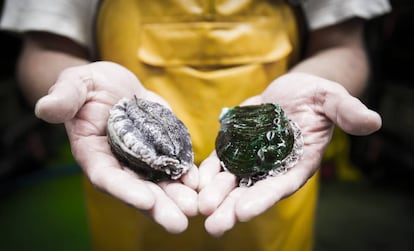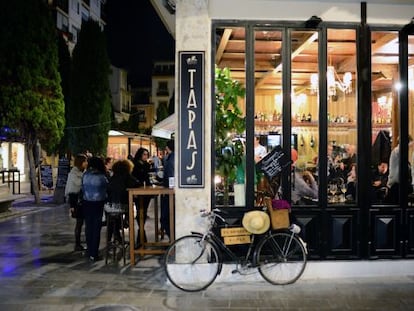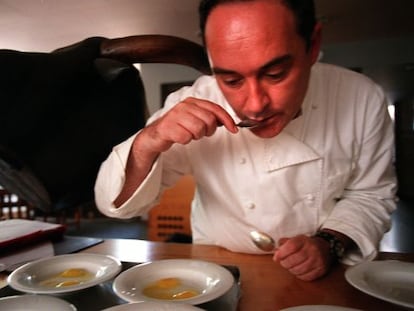Galicia produces the most exclusive seafood in the world
A fishfarm in Rías Baixas harvests bumper crops of abalone, a delicacy in East Asia and increasingly sought after in Europe

Ultrapure water, anti-stress prescriptions and homegrown algae are some of the pampering techniques used to rear exquisite abalone – a green and blue shellfish also known as ear shells or sea snails whose size matters but whose price does not, when sampled by the seafood connoisseurs on the other side of the world.
After 13 years of complex research, a small company founded by a group of biologists at the University of Santiago has managed to produce large abalones in a fish farm at the foot of the Rías Baixas, which will finish up 10,000 km away in some of the most exclusive restaurants in Japan, China and South Korea.
One of these four scientists is Óscar Santamaría, director of the project and co-founder of Galician Marine Aquaculture (GMA), who proudly displays a number of abalones measuring 9 cm, worth €10 apiece or €80 a kilo. They are the first abalones to be spawned and fostered in an area specifically selected for the quality of its water, which is sheltered from storms while facing the open sea.
Abalones are greedy eaters and feast for three years on these algae before they are ready to be eaten themselves. In their natural habitat, a kilo of abalones will devour 30% of their bodyweight a day
Bathed in this seawater, whose salt ratio, temperature, oxygen and bacteria content are monitored daily, these esteemed mollusks can grow happily after being spawned in a reproduction unit featuring a sign that commands “Maximum Silence”.

“In Asia, they are farmed on rafts in the open sea and they can’t control the quality of the water as we can here,” says Santamaría, referring to the only fish farm in Spain with haliotis discus hannai – the Japanese variety of abalone – and the biggest of Europe’s only three producers.
The biologists who got the project under way 13 years ago had the bright idea of setting up the farm while cultivating microalgae in their labs to feed the abalone larvae. This is the critical stage of an extremely delicate process in which chemical products have been vetoed by GMA.
It is due to the cultivation of this special food – as important to an abalone as a mother’s milk is to a human – that the Muros farm now produces such quality abalone. As they grow, they move on to macroalgae made in Burgos from a recipe that is also the brainchild of the Galicians.
Abalones are greedy eaters and feast for three years on these algae before they are ready to be eaten themselves. In their natural habitat, a kilo of abalones will devour 30% of their bodyweight a day. “We have to cultivate the algae ourselves or they would clean out the area,” says Santamaría.
Chefs from Galicia like Pedro Roca now feature abalone on their menu, a delicacy that the East Asian communities eat like sushi or sashimi, battered, grilled or “a feira” like octopus Galician-style. But despite being an expert on farming abalone, Santamaría finds it hard to describe the flavor. “It’s similar to octopus in texture, and to scallop in taste, but it’s not exactly the same. It tastes of the sea but not as strongly as the barnacle.”
The Muros abalone farm, which employs a staff of 23, cost €10 million before it began to turn a profit. The first investor prepared to put money into it was Rosalía Mera, the late co-founder of Inditex, some time after the project was first sketched out on a napkin in a bar in A Coruña by Santamaría and his partners.
Thirteen years later, the four molluscateers are exporting 40,000 kg to East Asia and 26,000kg to Europe with a prized 9.5cm abalone expected by the end of the year.
English version by Heather Galloway.
Sign up for our newsletter
EL PAÍS English Edition has launched a weekly newsletter. Sign up today to receive a selection of our best stories in your inbox every Saturday morning. For full details about how to subscribe, click here
Tu suscripción se está usando en otro dispositivo
¿Quieres añadir otro usuario a tu suscripción?
Si continúas leyendo en este dispositivo, no se podrá leer en el otro.
FlechaTu suscripción se está usando en otro dispositivo y solo puedes acceder a EL PAÍS desde un dispositivo a la vez.
Si quieres compartir tu cuenta, cambia tu suscripción a la modalidad Premium, así podrás añadir otro usuario. Cada uno accederá con su propia cuenta de email, lo que os permitirá personalizar vuestra experiencia en EL PAÍS.
¿Tienes una suscripción de empresa? Accede aquí para contratar más cuentas.
En el caso de no saber quién está usando tu cuenta, te recomendamos cambiar tu contraseña aquí.
Si decides continuar compartiendo tu cuenta, este mensaje se mostrará en tu dispositivo y en el de la otra persona que está usando tu cuenta de forma indefinida, afectando a tu experiencia de lectura. Puedes consultar aquí los términos y condiciones de la suscripción digital.
More information
Últimas noticias
Imelda Castro, the woman who wants to rule the cartel battleground of Sinaloa
The new victims of the Republican war on Obamacare: Millions hit by soaring health insurance premiums
A country divided on migrant rights: Some US states expand protections while others restrict them
Venezuela authorizes the release of another 87 political prisoners
Most viewed
- David King, chemist: ‘There are scientists studying how to cool the planet; nobody should stop these experiments from happening’
- Reinhard Genzel, Nobel laureate in physics: ‘One-minute videos will never give you the truth’
- Oona Chaplin: ‘I told James Cameron that I was living in a treehouse and starting a permaculture project with a friend’
- Sinaloa Cartel war is taking its toll on Los Chapitos
- The Interoceanic Train, the Mexican alternative to the Panama Canal











































